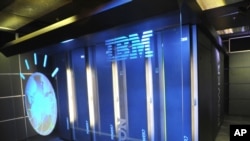IBM researchers have announced the development of a breakthrough software system designed to operate a new generation of cognitive computers that work like the human brain.
IBM said the new system is “inspired by the function, low power, and compact volume of the brain.” It could lead to an entire new era of computing with machines that learn and interact more naturally with people.
They say new machines could mimic the brain’s ability for “perception, action and cognition.”
The company says the long-term goal is to “build a chip system with ten billion neurons and hundred trillion synapses, while consuming merely one kilowatt of power and occupying less than two liters of volume.”
“Architectures and programs are closely intertwined and a new architecture necessitates a new [software] programming paradigm,” said Dr. Dharmendra S. Modha, a senior manager on the project.
While modern computing systems excel at number crunching, the amount of “Big Data” produced these days is pressing the limits of this old way of processing data. The brain, which operates more slowly than some modern-day computers is, however, much better at recognizing, interpreting and acting on patterns while using only the amount of energy required to light a 20 watt light bulb, while only occupying the space of a two-liter bottle.
This new ecosystem, according to IBM, is “tailored for a new class of distributed, highly interconnected, asynchronous, parallel, large-scale cognitive computing architectures.”
For example, the human eye takes in over a terabyte of data per day, interpreting the most important data for, say, navigation. Systems built from these new chips could lead to low power, lightweight eyeglasses to help the visually impaired.
To date, the most well-known cognitive computer is IBM’s Watson, which famously defeated two human competitors on a popular television quiz show.
These innovations are being presented at The International Joint Conference on Neural Networks in Dallas, Texas.
Here's a short video on the new concept:
IBM said the new system is “inspired by the function, low power, and compact volume of the brain.” It could lead to an entire new era of computing with machines that learn and interact more naturally with people.
They say new machines could mimic the brain’s ability for “perception, action and cognition.”
The company says the long-term goal is to “build a chip system with ten billion neurons and hundred trillion synapses, while consuming merely one kilowatt of power and occupying less than two liters of volume.”
“Architectures and programs are closely intertwined and a new architecture necessitates a new [software] programming paradigm,” said Dr. Dharmendra S. Modha, a senior manager on the project.
While modern computing systems excel at number crunching, the amount of “Big Data” produced these days is pressing the limits of this old way of processing data. The brain, which operates more slowly than some modern-day computers is, however, much better at recognizing, interpreting and acting on patterns while using only the amount of energy required to light a 20 watt light bulb, while only occupying the space of a two-liter bottle.
This new ecosystem, according to IBM, is “tailored for a new class of distributed, highly interconnected, asynchronous, parallel, large-scale cognitive computing architectures.”
For example, the human eye takes in over a terabyte of data per day, interpreting the most important data for, say, navigation. Systems built from these new chips could lead to low power, lightweight eyeglasses to help the visually impaired.
To date, the most well-known cognitive computer is IBM’s Watson, which famously defeated two human competitors on a popular television quiz show.
These innovations are being presented at The International Joint Conference on Neural Networks in Dallas, Texas.
Here's a short video on the new concept:









